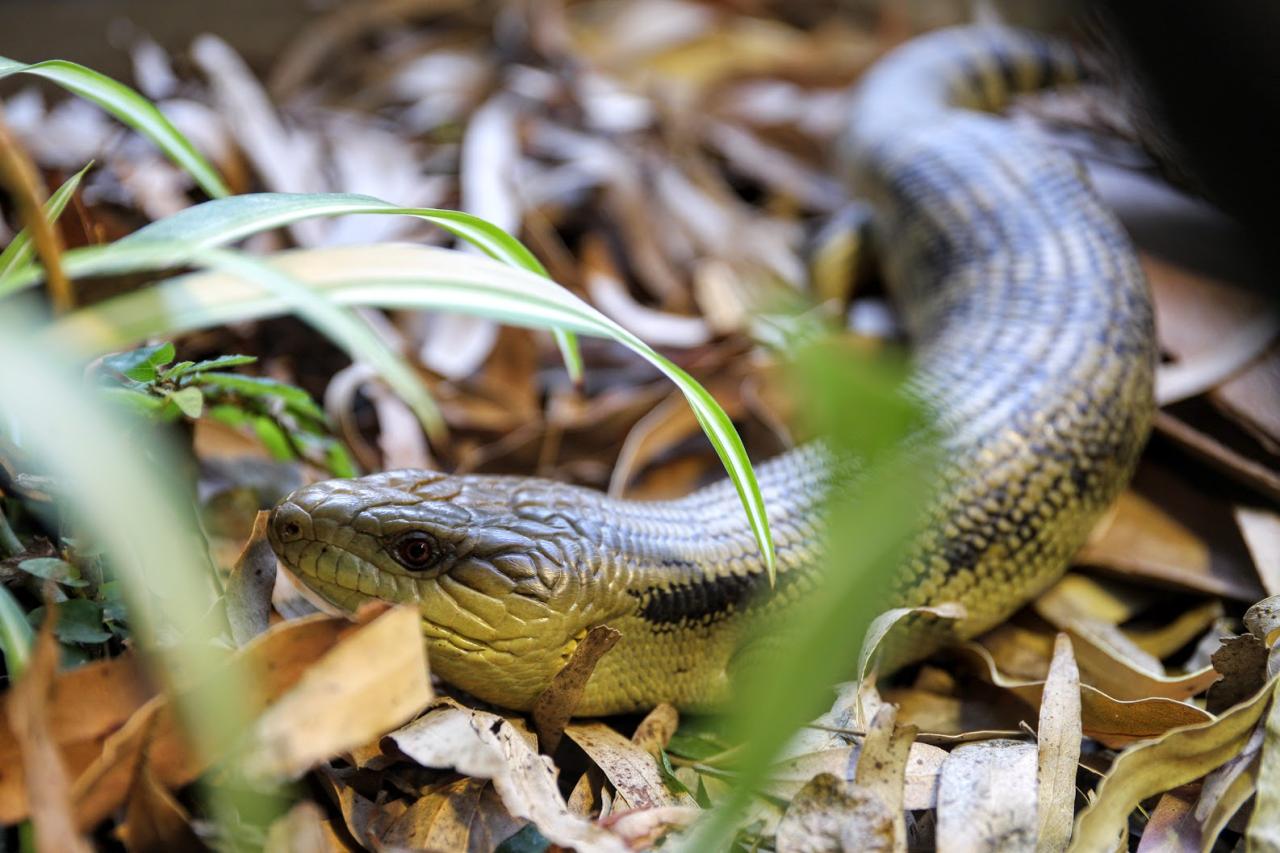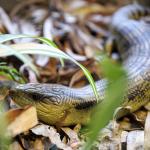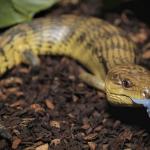- Home
- Herpetofauna Index
- Tiliqua Scincoides Scincoides
Tiliqua scincoides scincoides
Eastern blue-tongued skink
Tiliqua scincoides scincoides
(White, 1790)

Length: SVL up to 360mm, with the tail being shorter than the body length.
Weight: Wild individuals up to 600 grams
Description
A large Australian skink that is fairly common in captivity within New Zealand. They are characterised by their beautifully banded dorsal surfaces, which typically consist of 14-20 dark bands (primarily black, but may take on a dusty bronze/orange internal colouration, particularly towards their sides), interspersed by a silver to tan background colouration. The lower surfaces are somewhat plainer, with the background colouration ranging from silver/grey through to yellow, and the dark dorsal bands breaking up into several finer lines (giving the stomach a mottled appearance) or becoming absent. A black stripe often runs from the eye to the first dark band, although this may be broken or completely absent in some individuals. As the common name suggests this species is also notable for its large blue tongue which it uses as a threat display to alarm potential predators.
Life expectancy
Eastern blue-tongued skinks are known to live for up to 30 years in captivity. Wild animals may be able to reach similar ages but it is much less common.
Distribution
Should not occur in the wild in New Zealand (please report to MPI if located).
The eastern blue-tongued skink is endemic to the eastern half of Australia, occurring from Cape York in northern Queensland through to southern Victoria. They are mainly associated with less arid regions and accordingly, come much further inland in the eastern part of their range. Populations within South Australia are primarily coastal, reaching their distributional limit around the Eyre Peninsula, however, isolated populations occur in the far northwestern corner of the state in the Everard and Musgrave Ranges.
Ecology and habitat
Common blue-tongued skinks are a diurnal species that have adapted to living in urban environments throughout their range within Australia.
In the wild they tend to occur in open country, utilising large debris (logs, rocks, discarded rubbish) as refugia. During the winter months, they go into torpor (similar to hibernation) and only leave their refuge sites on warm days.
Eastern blue-tongued skinks have home ranges of around 12,700m2 for males, and 5,100m2 for females.
Social structure
Solitary, but will pair up during the breeding season (September-November). Can show extreme aggression between males, often biting each other inflicting nasty injuries.
Breeding biology
Ovoviviparous, giving birth to 5-20 (typically 10) live young between February and April.
The blue-tongued skink becomes sexually mature at around 2 years old (561-590 days), with the breeding season being September through to November.
Diet
Blue-tongued skinks are omnivorous and thus feed on a wide variety of animal and plant material. In the wild blue-tongued skinks tend to feed on plants, fruits, invertebrates, amphibians, small mammals, and other small reptiles. In captivity, they can be fed on a variety of garden insects including snails, locusts, and crickets as well as some non-toxic garden weeds such as dandelion, puha, plantain, and nasturtium (including the flowers of each).
Disease
Known to suffer from several issues relating to poor husbandry, including metabolic bone disease from inappropriate diet and/or lack of ultra-violet light provision and eye diseases accelerated by dry/dusty poorly ventilated enclosures.
Conservation
Classified by the IUCN as 'Least Concern'. Eastern blue-tongued skinks have relatively stable populations, mainly due to their ability to adapt to urban environments, rapid growth rates, early maturation, large litter sizes, and longevity.
Interesting notes
The eastern blue-tongued skink is a subspecies of the much wider-ranging common blue-tongued skink (Tiliqua scincoides). Other subspecies within this group include the northern blue-tongued skink (Tiligua scincoides intermedia) of northern Australia and the Tanimbar blue-tongued skink (Tiliqua scincoides chimaera) of Indonesia's Timur Laut/Tanimbar Islands.







